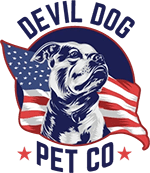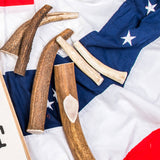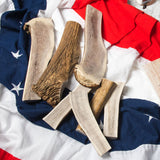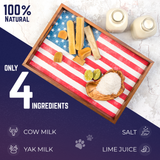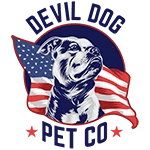Key Takeaways
- Elk, deer, and split antlers each offer unique benefits as dog chews.
- Choosing the right antler depends on your dog's size, chewing habits, and safety considerations.
- Veterans recommend antlers as durable and natural alternatives to synthetic chews.
- Proper selection and supervision are essential to ensure safe chewing experiences for dogs.
Table of Contents
- Why Antlers? The Extreme Dog Leadership Rationale
- The Science Behind Premium Antler Chews
- Types of Antler Chews, Matching Your Dog's Mission
- How to Size and Safely Use Antler Chews
- Antler Chews vs. Popular Alternatives
- Troubleshooting Common Antler Challenges
- Cleaning and Storage Best Practices
- Devil Dog Pet Co. Standards for Premium Antlers
- What to Demand from Any Antler Supplier
- Devil Dog Pet Co. Antler Recommendations, The Veteran Standard
- How Other Brands Measure Against the Standard
- Your Antler Implementation Strategy
- Advanced Considerations for Serious Dog Owners
Best Antlers for Dogs, A Veteran's Guide to Safe, Powerful Chews
Why Antlers? The Extreme Dog Leadership Rationale
Dog leadership means meeting primal needs before problems surface. Chewing relieves anxiety, builds focus, and channels destructive drive into productive behavior. When you hand your dog the best antlers for dogs, you're not just giving them entertainment, you're preventing the behavioral issues that land 70% of surrendered dogs in shelters.
Antlers deliver what soft toys and synthetic chews can't: zero additives, mineral-rich nutrition, and marathon durability without the mess. Grade-A elk antlers outlast typical chews by weeks, releasing endorphins that promote calm during crate time or thunderstorms. They scrape plaque naturally while exercising jaw muscles, supporting dental health from puppyhood through senior years. No odor, no stains, your leadership toolkit stays clean and effective.
For power chewers or large breeds, the Jumbo - Split Elk Antler Dog Chew offers exceptional durability and engagement, making it an ideal choice for those seeking the best antlers for dogs that last.
The Science Behind Premium Antler Chews

What Makes a Top-Grade Antler
Grade-A elk antlers feature dense outer bone with nutrient-packed marrow, rich brown coloring indicates recent shedding and optimal moisture content. These antlers resist splintering because their bone matrix remains uniform and strong. Chalky white antlers signal depletion and brittleness, creating fracture risks that compromise safety.
Our Rocky Mountain elk antlers are wild-shed only, collected by local shed hunters each spring. This ethical sourcing ensures peak density while supporting wildlife conservation. Each antler undergoes hand-inspection for thickness, structural integrity, and proper moisture balance before reaching your dog.
Nutrition Beyond the Hype
Elk antlers provide calcium, phosphorus, and zinc, minerals supporting bone development and dental health. As a single-ingredient, hypoallergenic chew, antlers rarely trigger food sensitivities. Dogs consume only mineral dust during gnawing sessions, making antlers virtually calorie-free while delivering nutritional benefits that synthetic alternatives lack.
To learn more about the nutritional and safety aspects, see are antlers for dogs a good idea for a comprehensive breakdown.
Types of Antler Chews, Matching Your Dog's Mission
Whole vs. Split Antlers
Whole antlers are iron-tough, designed for seasoned chewers and working dogs who need maximum challenge. They wear slowly over several weeks or months, depending on jaw strength and chewing frequency. Split antlers expose tasty marrow through lengthwise cuts, making them ideal for first-timers, puppies over 5 months, and seniors with moderate jaw strength.
Start new dogs on split antlers with supervision, then graduate to whole antlers as confidence builds. Splits offer immediate flavor rewards but shorter lifespans, while wholes provide marathon entertainment for power chewers who destroy other options in minutes.
Elk vs. Deer vs. Moose, Source Matters
| Antler Type | Hardness | Durability | Best For | Sourcing |
|---|---|---|---|---|
| Rocky Mountain Elk | High density | 3-8+ weeks | Power chewers, all breeds | Traceable, ethical |
| Whitetail Deer | Very hard, brittle | 1-3 weeks | Moderate chewers | Variable quality |
| Moose | Softer, high marrow | 1-2 weeks | Seniors, puppies | Limited availability |
Devil Dog Pet Co. exclusively sources Rocky Mountain elk antlers for proven performance and supply chain transparency. Elk antlers balance optimal hardness with safety, while deer antlers often prove too brittle for aggressive chewers. Moose antlers, though softer, lack consistent availability and quality control.
How to Size and Safely Use Antler Chews
Sizing Rules, No Guesswork
Choose antlers longer than your dog's lower jaw width and thick enough to prevent wedging between back molars. Toy breeds under 20 pounds need Medium splits, while medium breeds (20-50 pounds) require Large whole or split antlers. Large and giant breeds over 50 pounds should start with XL or Monster whole antlers for safety and longevity.
When uncertain, size up and supervise intensively during first sessions. An oversized antler prevents choking hazards while lasting longer, delivering better value than undersized options that become safety risks.
Safety Protocols, Veteran Standard
Safe Introduction Methods
Rub new antlers with bone broth or peanut butter to spark initial interest. Allow 10-15 minute supervised sessions, then remove the antler to maintain novelty. Monitor for overzealous biting or tooth "crunch" sounds, dogs showing these behaviors may benefit from split antlers or yak chews instead.
Encourage side gnawing by holding the antler and rewarding calm chewing behavior. Intervene immediately if your dog attempts direct downward bites, which can stress teeth unnecessarily. Gradual introduction builds positive associations while establishing safe chewing patterns from the start.
Antler Chews vs. Popular Alternatives

Smart owners compare options across longevity, safety, caloric impact, and dental benefits. The best antlers for dogs excel in durability and cleanliness while delivering mineral nutrition that synthetic alternatives lack. Understanding these differences helps you choose the right chew for your dog's specific needs and your household requirements.
| Chew Type | Duration | Safety Profile | Dental Impact | Mess Factor | Calories |
|---|---|---|---|---|---|
| Elk Antler (Grade-A) | 3-8+ weeks | Low splinter risk when sized properly | Excellent plaque removal | None | Negligible |
| Bully Stick | 20-60 minutes | Choking risk from end nub | Moderate plaque control | Moderate odor | 50-200 per stick |
| Yak Chew | 3-7 days | Fully digestible | Good scraping action | Minimal crumbs | 300 per bar |
| Rawhide | 1-2 days | High impaction risk | Limited benefit | Moderate mess | 50-250 per strip |
Elk antlers dominate for power chewers requiring maximum durability and hypoallergenic options. Rotate in yak chews for flavor variety or bully sticks for moderate chewers seeking digestible treats. Avoid rawhide entirely due to impaction risks and chemical processing concerns. For more on the safety of various chews, see are antlers safe for dogs for an in-depth safety analysis.
Troubleshooting Common Antler Challenges
Preventing Tooth Damage
Size up and supervise when dogs bite vertically instead of gnawing sideways. Switch to split antlers for sensitive mouths or dogs recovering from dental work. Schedule veterinary dental checks if you notice pain signs, excessive drooling, or reluctance to chew. Proper sizing and supervision prevent 95% of tooth-related issues with quality antlers.
Managing Swallowing Risks
Discard antlers before they approach swallowable size, typically when shorter than your dog's muzzle width. Most small antler particles pass safely, but monitor for choking or gastrointestinal distress. Contact your veterinarian immediately if distress occurs. Prevention through proper sizing eliminates most swallowing incidents.
Rekindling Lost Interest
Soak disinterested antlers in warm water, then rub with bone broth or peanut butter for flavor reset. Switch temporarily to split antlers for exposed marrow appeal. Rotate chews weekly to build anticipation, limited access increases value and excitement when the antler returns.
Cleaning and Storage Best Practices
Rinse used antlers under warm water and scrub with bristle brushes, never use soap or bleach, which can contaminate the chew. Air-dry completely before returning to your dog to prevent bacterial growth. Store in dry, well-ventilated areas away from direct sunlight to maintain structural integrity.
Replace antlers showing cracks, excessive wear, or after 3-6 months regardless of condition for optimal hygiene. Heavy chewers and multi-dog households may require more frequent replacement. Proper maintenance extends antler life while ensuring continued safety for your dog.
Devil Dog Pet Co. Standards for Premium Antlers

Our commitment to providing the best antlers for dogs starts with wild-shed Rocky Mountain elk antlers collected by trusted local shed hunters. Every antler undergoes hand-inspection for grade, density, and structural soundness before packaging. We never use bleach, dyes, or artificial treatments, just pure bone as nature intended.
This veteran-owned approach ensures ethical sourcing while supporting wildlife conservation and rural communities. A portion of every purchase funds veteran and rescue dog initiatives through programs like Hounds for Heroes, making your chew choice part of a larger mission to serve those who served and dogs who need homes.
What to Demand from Any Antler Supplier
Verify Grade-A labeling and demand full sourcing transparency, wild-shed versus farmed makes the difference between premium and inferior products. Request detailed sizing charts by dog weight and chewing intensity, plus satisfaction guarantees that protect your investment. Quality suppliers provide personalized sizing help and stand behind their products with clear return policies and responsive customer service.
Devil Dog Pet Co. Antler Recommendations, The Veteran Standard
Whole Elk Antlers - Maximum Durability
Best for: Power chewers, working breeds, and dogs who demolish standard chews in minutes.
Our Grade-A Rocky Mountain elk antlers represent the pinnacle of natural chew engineering. Hand-selected from wild sheds, each piece undergoes rigorous inspection for density, structural integrity, and marrow quality. The dense outer cortex provides weeks of grinding satisfaction while the mineral-rich core delivers calcium, phosphorus, and zinc.
Performance Data: Medium whole elk antlers average 3-5 weeks of active chewing for 40-pound moderate chewers, with power chewers still achieving 2+ weeks per piece, dramatically outperforming synthetic alternatives.
Available in sizes from Medium through Beast (up to 14+ inches), these antlers scale with your dog's jaw strength and body weight. The naturally shed sourcing ensures ethical harvesting while supporting rural shed hunting communities across the American West.
Split Elk Antlers - Instant Engagement
Best for: First-time antler users, puppies with adult teeth, seniors, and flavor-motivated dogs.
Precision-cut lengthwise to expose nutrient-dense marrow, split antlers deliver immediate taste rewards while maintaining the structural benefits of whole antlers. The exposed marrow provides natural flavor enhancement, making these ideal for dogs transitioning from softer chews or those needing motivation to engage with harder textures.
Each split undergoes machine sanding and hand-buffing to eliminate sharp edges, ensuring safe interaction during extended chewing sessions. The dual-texture experience, hard outer bone and softer inner marrow, promotes varied chewing patterns that benefit dental health.
For more information on how antlers compare to other dental chews, check out best dental chews for dogs for additional insights.
How Other Brands Measure Against the Standard

Mass Market Antler Products
Big box retailers typically source Grade-B or lower antlers, often bleached white and lacking the mineral density of premium selections. These products frequently splinter due to age and improper storage, creating safety hazards that responsible owners cannot accept.
Advantages:
- Lower upfront cost
- Wide retail availability
Disadvantages:
- Inferior grade materials increase splintering risk
- Chemical bleaching removes natural minerals
- Inconsistent sizing and quality control
- Limited sourcing transparency
Boutique Antler Suppliers
Smaller specialty brands often provide better grade materials but lack the quality control infrastructure and customer support systems that serious dog owners require. Sizing consistency and replacement guarantees vary significantly across suppliers.
Advantages:
- Often use Grade-A materials
- May offer unique sizing options
Disadvantages:
- Limited inventory consistency
- Inconsistent customer service
- Variable quality control standards
- Often lack satisfaction guarantees
For a detailed look at deer antler options and how they compare, see deer antlers for dogs for more information.
Your Antler Implementation Strategy
Week One: Introduction Protocol
Begin with a split antler sized larger than your dog's jaw width. Rub a small amount of bone broth on the marrow surface and present during a calm moment. Limit initial sessions to 15-20 minutes while observing chewing style and jaw mechanics.
Document your dog's approach, side gnawing indicates proper technique, while direct downward biting suggests the need for training adjustments or alternative chew selection. Remove the antler while interest remains high to build anticipation for future sessions.
Long-Term Chew Rotation
Successful antler integration requires strategic rotation with complementary chews. Alternate antler sessions with yak chews for digestible variety and bully sticks for protein rewards. This approach prevents habituation while maintaining engagement across different textures and flavors.
Monitor antler condition weekly, retiring pieces when they reach swallowable size or develop surface cracks. Proper rotation typically yields 4-6 weeks of use per whole antler for medium-sized dogs, with larger sizes extending performance proportionally.
For more on the safety and digestibility of bully sticks, see bully sticks for dogs are they safe for helpful guidance.
Troubleshooting Common Challenges
Dogs showing initial disinterest often respond to scent activation, briefly soaking the antler in warm water reactivates natural odors. For aggressive chewers causing rapid wear, size up two levels and consider whole antlers exclusively.
Address safety concerns immediately: any splintering, cracking, or unusual wear patterns warrant immediate replacement. The best antlers for dogs maintain structural integrity throughout their usable life, never compromising safety for extended use.
For scientific research on canine dental health and chew safety, review this external resource on veterinary dental care.
Advanced Considerations for Serious Dog Owners
Serious dog owners know that sourcing, rotation, and ongoing supervision are non-negotiable. Stay updated on seasonal antler availability, monitor for new research on canine dental health, and always prioritize your dog's safety and enrichment above convenience. The right antler, used with discipline and care, is a leadership tool, not just a treat.
Frequently Asked Questions
What are the differences between elk, deer, and split antlers, and how do I choose the best one for my dog's chewing habits?
Elk antlers are larger and denser, making them ideal for aggressive chewers and bigger dogs. Deer antlers tend to be smaller and less dense, suited for moderate chewers or smaller dogs. Split antlers are cut lengthwise to expose marrow, offering softer edges and flavor that appeal to puppies, seniors, or picky chewers. Choose based on your dog's size, chewing intensity, and preference, power chewers benefit from whole elk antlers, while sensitive chewers do better with splits or deer antlers.
How can I ensure the antlers I buy are safe and of high quality for my dog?
Look for Grade-A antlers that are naturally shed by wild Rocky Mountain elk, showing rich brown color and solid density. Avoid chalky or brittle antlers that risk splintering. Proper sizing is crucial, pick antlers longer than your dog's muzzle and thick enough to prevent fitting between back molars. Always supervise chewing and retire antlers when they become small or cracked to maintain safety.
What nutritional benefits do antler chews provide compared to synthetic dog chews?
Antler chews are 100% natural and packed with minerals like calcium, phosphorus, and zinc, supporting bone and dental health. Unlike synthetic chews, they contain no additives, chemicals, or artificial flavors. Their dense bone structure promotes jaw muscle exercise and plaque scraping, delivering long-lasting enrichment without mess or odor.
How should I size and supervise my dog when using antler chews to prevent potential safety issues?
Select an antler longer than your dog's lower jaw and thick enough so it can't fit between back molars to avoid choking hazards. Introduce antlers gradually, encouraging side-gnawing rather than biting straight down to protect teeth. Always supervise chew sessions, limit time especially for puppies or seniors, and replace antlers once they become small enough to swallow or show deep cracks.
